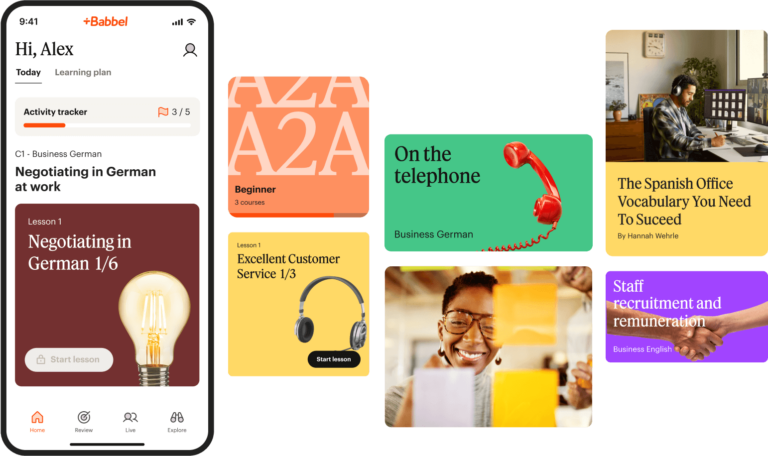Babbel as a Corporate Benefit
Are you looking for a flexible and engaging employee benefit that offers real added value? Babbel for Business’s online language courses provide flexible learning and improved employee satisfaction.

Why invest in language learning?
82%
of employees would like training in business English
67%
of companies think multilingual teams lead to more innovation
7/10
employees wish for language courses in the workplace
1/4
US employers lost business due to lack of foreign language skills

More employee satisfaction
Learning a new language is a personal development goal for many people. With Babbel for Business, it’s particularly easy to achieve it.
Better
understanding
Foreign language skills promote improved communication abilities. This has a positive impact on multicultural teams and the overall work environment.
More diversity
Learning languages automatically exposes participants to foreign cultures. This increases awareness of the value of diversity and promotes a cosmopolitan company culture.
Why choose Babbel for Business?
91%
of users are happy learning with Babbel for Business
2.5x
faster language learning success than other services
75%
of our learners have achieved their language goals
99%
of first time users said they would continue to use Babbel

Our blended learning solutions

Control Panel

Babbel Live

The Babbel App
Over 2,000 satisfied companies
John Shin
Director of Risk Management
Monarch Landscaping
Landscaping Industry
“It’s priceless. You’re able to speak with your crew in Spanish, and it builds camaraderie and trust. Our people enjoy it. We’ve had nothing but positive feedback.”
Wildlife Works



FAQs
Babbel for Business stands out as the premier choice for corporate language training, offering an unparalleled combination of cutting-edge technology, expert-led instruction, and comprehensive support. Our solution surpasses traditional language learning methods by providing a uniquely effective and flexible approach tailored to the modern workplace. Here’s why Babbel for Business is the best in the industry:
– Self-Paced Learning with the Babbel App: Accessible via web and mobile, the app provides bite-sized lessons designed for on-the-go learning. Courses are crafted by linguists and cover 14 languages, including business-specific and industry-focused content.
– Blended Learning methodology: This approach integrates digital self-study with live online classes, ensuring learners benefit from both structured learning and real-time interaction with certified teachers. This combination accelerates language acquisition and retention.
– Interactive Live Classes: Babbel Live offers group and private classes tailored to professional contexts, providing immediate feedback and conversation practice. Classes are available 24/7, accommodating different time zones and schedules.
– Effortless Management with the Control Panel: Administrators can manage and track the language learning program seamlessly through a user-friendly Control Panel, which provides detailed analytics and reporting.
– Dedicated Support Teams: The Customer Success and Learner Success teams provide ongoing support to ensure the program aligns with organizational goals. They offer resources, workshops, and personalized guidance to maximize learner engagement and success.
– AI-Enhanced Learning: The app includes AI-powered conversation practice, allowing learners to engage in realistic scenarios anytime, enhancing their speaking skills and confidence.
Babbel for Business is designed to support multilingual communication and professional development, making it an effective solution for organizations aiming to improve internal and external communication.
Learning a new language offers many advantages for companies including better internal communication between multilingual teams, a safer work environment, enhanced customer service, increased efficiency and productivity, and an ability to fuel company growth.
Work processes will be optimized across teams, leading to seamless collaboration and streamlined projects that reduce errors and improve overall productivity. Corporate language training is also essential for companies that are required to follow certain safety procedures. You’ll be able to equip your employees with the language skills necessary to understand protocols and reduce accidents as a result. Corporate language learning will also help to build trust with your customer base and increase overall satisfaction with the work done.
Babbel for Business excels in enhancing Business English through a wealth of business and industry-specific content, developed by linguistic experts. Our platform offers:
– Specialized courses: Extensive modules tailored to various industries including healthcare, IT, finance, and hospitality, focusing on practical business communication skills such as email writing, negotiations, and presentations.
– Live classes led by expert instructors: Professional teachers trained in relevant business topics, providing real-time feedback and guidance to ensure practical application of language skills in professional settings.
– Real-world scenarios: Courses incorporate actual business situations, enabling learners to apply new vocabulary and concepts directly to their daily work.
– Continuous updates: Our content is regularly updated to reflect the latest trends and terminology in the business world, keeping your team’s skills current and competitive.
This approach not only boosts proficiency in Business English but also aligns language learning with specific professional needs, ensuring that employees are well-prepared for international business communications.
Depending on your learning goals and needs, Babbel for Business offers different product options:
The Babbel App is well suited as a long-lasting employee benefit to offer your team a useful opportunity for continuing education.
If you want to tackle a specific need, you can complement the Babbel App with Babbel Live: online one-to-one or group lessons, with dedicated teachers.


